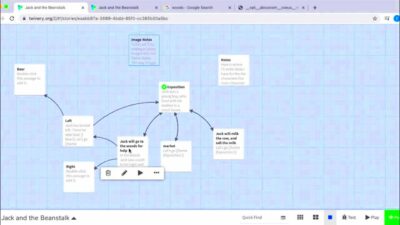Market research is the backbone of any successful Etsy shop. It provides insights that help you understand your audience, refine your strategies, and outshine your competition. Here’s why investing time in market research is essential for Etsy success:
1. Understanding Your Target Audience
Market research helps you identify who your potential customers are and what they are looking for. This information is vital for creating products that meet their needs and preferences. Key aspects to explore include:
- Demographics: Age, gender, location, and income level of your target customers.
- Psychographics: Interests, lifestyle choices, and values that influence purchasing decisions.
- Buying Behavior: What motivates customers to make a purchase and how often they shop on Etsy.
2. Identifying Market Trends
Staying updated with the latest trends can give you a competitive advantage. Market research allows you to:
- Spot Emerging Trends: Find out what’s currently popular and what’s gaining traction.
- Adjust Your Product Offerings: Align your product line with the latest trends to meet demand.
- Forecast Future Trends: Predict upcoming shifts in the market to stay ahead.
3. Analyzing Your Competitors
Understanding what your competitors are doing can reveal opportunities and threats in your market. Key areas to analyze include:
| Competitor Aspect | What to Analyze |
|---|---|
| Product Range | Types of products offered, pricing, and unique selling points. |
| Customer Reviews | Strengths and weaknesses as perceived by customers. |
| Marketing Strategies | How they promote their products and engage with customers. |
| Sales Performance | Best-selling items and overall sales volume. |
4. Making Informed Business Decisions
Market research provides data-driven insights that help you make strategic decisions, such as:
- Pricing Strategies: Set competitive prices based on market demand and competitor pricing.
- Product Development: Develop new products or improve existing ones based on customer feedback.
- Marketing Approaches: Choose the best marketing channels and techniques for your target audience.
By investing in thorough market research, you not only understand your market better but also set a solid foundation for your Etsy shop’s success. Remember, well-researched strategies lead to better decisions, which can result in increased sales and growth.
Understanding Your Target Audience on Etsy

To achieve success on Etsy, it’s essential to have a deep understanding of your target audience. Knowing who your customers are and what they want will help you tailor your products and marketing strategies to meet their needs. Here’s a comprehensive guide on how to understand your target audience on Etsy:
1. Define Your Ideal Customer
Start by creating a detailed profile of your ideal customer. This process involves gathering information about who they are and what motivates them. Key elements to include are:
- Age: What is the typical age range of your customers? Are they teenagers, young adults, or older individuals?
- Gender: Is your product aimed more at men, women, or a specific gender-neutral audience?
- Location: Are your customers from a specific geographic area or spread across different regions?
- Income Level: What is the general income level of your target audience? Are they budget-conscious or willing to spend more for premium products?
- Interests: What are their hobbies and interests? Are they into handmade crafts, vintage items, or personalized gifts?
2. Research Customer Behavior on Etsy
Understanding how customers interact with Etsy can provide insights into their behavior and preferences. Consider the following methods:
- Browse Etsy Forums: Check out forums and discussion threads to see what buyers are talking about and what they’re looking for.
- Read Reviews: Look at reviews of similar products to identify what customers appreciate or dislike.
- Analyze Etsy Analytics: Use Etsy’s built-in analytics to track visitor behavior, such as which listings are popular and how customers find your shop.
3. Conduct Surveys and Polls
Direct feedback from potential customers can be very insightful. You can:
- Create Online Surveys: Use tools like Google Forms or SurveyMonkey to ask potential customers about their preferences and needs.
- Run Social Media Polls: Engage with your audience on social media platforms to gather opinions and preferences.
4. Use Buyer Personas
Develop buyer personas to represent different segments of your audience. A buyer persona is a fictional character that embodies the traits of your ideal customer. Each persona should include:
| Persona Element | Description |
|---|---|
| Name: | Give your persona a name to make them relatable. |
| Background: | Describe their job, lifestyle, and daily activities. |
| Goals: | What are their main goals and aspirations related to your products? |
| Challenges: | What obstacles do they face that your products can help solve? |
| Buying Behavior: | How do they make purchasing decisions? What influences their choices? |
5. Monitor Trends and Adjust Strategies
Regularly monitor changes in customer preferences and market trends. Be prepared to adjust your strategies based on:
- Seasonal Trends: Seasonal items or holiday-specific products can attract more buyers at certain times of the year.
- Feedback: Use customer feedback to make improvements or changes to your products and services.
- Market Research Updates: Stay informed about market research trends to keep your strategies relevant and effective.
By understanding your target audience, you can create products that resonate with them, design effective marketing campaigns, and ultimately drive success for your Etsy shop.
Also Read This: Legal Labyrinth: A Guide on How to Sue eBay in Small Claims Court
Key Tools and Techniques for Effective Market Research
Effective market research requires the right tools and techniques to gather, analyze, and interpret data about your market and audience. Here are some essential tools and techniques that can help you conduct thorough market research for your Etsy shop:
1. Online Market Research Tools
These tools can help you gather data on market trends, customer behavior, and competitor analysis:
- Google Trends: Use Google Trends to explore search trends over time and identify popular keywords related to your products.
- SEMrush: SEMrush provides insights into competitor keywords, SEO strategies, and market trends.
- Ahrefs: Ahrefs offers tools for keyword research, backlink analysis, and competitor research.
- BuzzSumo: With BuzzSumo, you can find popular content, track social media engagement, and identify influencers in your niche.
2. Social Media Insights
Social media platforms offer valuable data on customer preferences and trends:
- Facebook Insights: Use Facebook Insights to analyze page performance, audience demographics, and engagement metrics.
- Instagram Analytics: Track follower growth, post engagement, and popular hashtags with Instagram Analytics.
- Twitter Analytics: Use Twitter Analytics to monitor tweet performance, follower activity, and trending topics.
3. Customer Feedback and Reviews
Direct feedback from customers can provide insights into their needs and preferences:
- Customer Reviews: Analyze reviews on your Etsy shop and similar products to understand what customers like or dislike.
- Surveys and Polls: Create surveys using SurveyMonkey or Google Forms to gather feedback on your products and services.
- Product Testing: Offer sample products to a select group of customers and collect their opinions.
4. Competitor Analysis Techniques
Understanding your competitors can reveal opportunities for your shop:
- Competitor Analysis Tools: Use tools like SpyFu or CompeteShark to analyze competitors’ marketing strategies and performance.
- Competitive Pricing Analysis: Compare your prices with those of similar products to ensure your pricing is competitive.
- Review Competitors’ Products: Examine the features, quality, and presentation of your competitors’ products.
5. Data Analysis Techniques
Once you’ve collected data, you need to analyze it effectively:
- Data Visualization: Use tools like Tableau or Excel for creating charts, graphs, and dashboards.
- SWOT Analysis: Perform a SWOT Analysis (Strengths, Weaknesses, Opportunities, Threats) to evaluate your position in the market. Here's a simple table for a SWOT Analysis:
| Strengths | Weaknesses |
|---|---|
| Unique product offerings | High production costs |
| Strong brand identity | Limited market reach |
| Opportunities | Threats |
| Growing trend for handmade items | Increasing competition |
| Expanding into new markets | Changing consumer preferences |
By utilizing these tools and techniques, you can gain a comprehensive understanding of your market and make informed decisions to enhance your Etsy shop's success.
Also Read This: Finding the Best Technology Colleges That Emphasize Practical Learning in the USA
Analyzing Etsy Competitors: What to Look For
Analyzing your competitors on Etsy is a critical step in developing effective strategies for your own shop. By examining what your competitors are doing, you can uncover opportunities for differentiation, identify best practices, and spot potential threats. Here’s a detailed guide on what to look for when analyzing Etsy competitors:
1. Product Offerings and Range
Understanding what products your competitors offer can help you identify gaps in the market and opportunities for your own shop. Focus on the following aspects:
- Product Variety: What types of products do they offer? Are they focusing on a specific niche or a broad range of items?
- Product Quality: Assess the quality of their products through photos, descriptions, and reviews. Are their products well-made and presented?
- Unique Selling Propositions (USPs): What makes their products unique? Look for features like customization options, special materials, or unique designs.
2. Pricing Strategies
Understanding competitors' pricing strategies can help you set competitive prices for your own products. Consider the following:
- Price Points: What is the range of prices for their products? Are they positioned as budget-friendly, mid-range, or premium?
- Discounts and Promotions: Do they offer any sales, discounts, or promotional deals? How frequently do they run these promotions?
- Shipping Costs: What are their shipping rates and policies? Do they offer free shipping, and if so, under what conditions?
3. Marketing and Branding Strategies
Analyze how competitors market their products and build their brand:
- Product Descriptions: Examine their product titles, descriptions, and keywords. Are they clear, engaging, and optimized for search engines?
- Visual Appeal: Look at their product photos, shop banners, and overall shop aesthetics. How professional and appealing are their visuals?
- Social Media Presence: Check their social media profiles. How do they engage with their audience? What type of content do they share?
4. Customer Reviews and Feedback
Customer reviews can provide insights into a competitor’s strengths and weaknesses:
- Review Ratings: What is the overall rating of their products? Are there any recurring issues mentioned in the reviews?
- Customer Comments: Look for feedback on product quality, shipping, customer service, and more. Are there any common complaints or praises?
- Response to Reviews: How do they respond to positive and negative reviews? Are they proactive in addressing customer concerns?
5. Shop Policies and Customer Service
Understanding a competitor’s shop policies and customer service can help you enhance your own practices:
- Return and Exchange Policies: What are their policies on returns and exchanges? Are they customer-friendly?
- Customer Service: Evaluate their responsiveness to customer inquiries. How quickly do they respond to questions or issues?
- Shipping and Handling: What are their shipping policies? Do they provide tracking information and timely deliveries?
6. Competitor Analysis Table
Here’s a simple table you can use to compare competitors based on the factors listed above:
| Factor | Competitor A | Competitor B | Competitor C |
|---|---|---|---|
| Product Range | Wide variety | Niche products | Broad range |
| Price Points | Mid-range | Premium | Budget-friendly |
| Unique Selling Points | Custom designs | High-end materials | Affordable prices |
| Marketing Strategies | Active on Instagram | Blog posts and SEO | Email marketing |
| Customer Reviews | 4.5 stars | 4 stars | 4.2 stars |
| Return Policies | 30-day returns | No returns | 14-day returns |
By analyzing these aspects of your Etsy competitors, you can develop strategies that leverage your strengths, address market gaps, and position your shop for success.
Also Read This: Email Evader: Bypassing eBay Email Message Filters
How to Use Etsy Analytics for Market Research
Etsy Analytics is a powerful tool that provides insights into your shop’s performance, helps you understand customer behavior, and guides your market research efforts. Here’s a comprehensive guide on how to effectively use Etsy Analytics for market research:
1. Accessing Etsy Analytics
To start using Etsy Analytics, follow these steps:
- Log In: Sign in to your Etsy account.
- Navigate to Shop Manager: Click on “Shop Manager” in the top-right corner of the screen.
- Select Analytics: From the menu, choose “Analytics” to access your shop’s performance data.
2. Key Metrics to Monitor
Once you’re in Etsy Analytics, focus on these key metrics to gather valuable market research data:
- Traffic Sources: Understand where your visitors are coming from by reviewing traffic sources. Look for:
- Direct Traffic: Visitors who come directly to your shop.
- Search Engines: Visitors who find your shop through search engines like Google.
- Etsy Search: Visitors who find you through Etsy’s internal search.
- Social Media: Visitors who come from platforms like Facebook or Instagram.
- Other Websites: Visitors coming from other websites or blogs.
- Conversion Rate: This metric shows the percentage of visitors who make a purchase. A higher conversion rate indicates effective product listings and marketing strategies.
- Top Listings: Identify which products are performing best. Look for metrics such as views, favorites, and sales for each listing.
- Revenue and Sales Trends: Track your overall revenue and sales trends over time. Look for patterns, such as seasonal fluctuations or sales spikes.
3. Analyzing Customer Behavior
Use these analytics tools to gain insights into customer behavior:
- Customer Searches: Review the search terms that lead customers to your shop. This information helps you optimize your product titles and tags.
- Customer Locations: Identify where your customers are located. This information can guide your marketing efforts and shipping strategies.
- Behavioral Insights: Analyze how customers interact with your shop. Look at metrics such as page views per visit and average time spent on your shop.
4. Leveraging Analytics for Market Research
Use the data from Etsy Analytics to make informed decisions:
- Optimize Listings: Adjust your product descriptions, titles, and tags based on search terms and top-performing listings.
- Enhance Marketing Efforts: Focus on traffic sources that drive the most visitors to your shop. Invest more in successful channels, such as social media or Etsy ads.
- Identify Growth Opportunities: Look for trends and patterns in your sales data to identify new product ideas or potential market expansions.
- Improve Customer Experience: Use feedback from reviews and customer behavior insights to make improvements in your product offerings and customer service.
5. Etsy Analytics Dashboard Overview
Here’s a simple overview of the main sections of the Etsy Analytics dashboard:
| Analytics Section | Description |
|---|---|
| Overview | Gives a snapshot of your shop’s performance including revenue, orders, and traffic statistics. |
| Traffic Sources | Shows where your visitors are coming from and the effectiveness of different marketing channels. |
| Listings | Provides data on views, favorites, and sales for each product listing. |
| Sales | Tracks your sales performance over time, including revenue trends and average order values. |
| Customer Insights | Shows customer demographics, including location and search behavior. |
By leveraging these features of Etsy Analytics, you can gain valuable insights into your shop’s performance and make data-driven decisions to improve your market presence and drive success.
Also Read This: Explore How to Download Photos from IMDB with This Easy Guide
Trends and Insights: Where to Find the Latest Etsy Trends
Staying up-to-date with the latest trends on Etsy is essential for maintaining a competitive edge and ensuring that your products meet market demands. Here’s a guide on where to find the latest Etsy trends and how to use this information to your advantage:
1. Etsy’s Trend Reports and Features
Etsy regularly publishes trend reports and features that can help you identify popular products and emerging trends:
- Etsy Seller Handbook: Visit the Etsy Seller Handbook for articles and resources about the latest trends, marketing strategies, and best practices.
- Etsy Blog: Check the Etsy Blog for updates on trends, success stories, and trend forecasts.
- Etsy Trend Reports: Read seasonal and annual trend reports published by Etsy, which highlight popular products, colors, and styles. Look for reports like Etsy Trend Reports.
2. Social Media Platforms
Social media is a rich source for discovering current trends and gaining insights into what’s popular:
- Instagram: Follow hashtags like #EtsyFinds, #EtsyTrend, and #EtsySeller to see trending products and new ideas. Explore accounts of popular Etsy shops for inspiration.
- Pinterest: Use Pinterest to find trending ideas and inspirations. Search for Etsy trends or explore boards dedicated to Etsy finds and new trends.
- Facebook Groups: Join Facebook groups for Etsy sellers and crafters. Groups such as Etsy Seller Support Group often discuss current trends and market demands.
3. Trend Aggregator Websites
Trend aggregator websites provide comprehensive overviews of current trends across various industries:
- TrendWatching: Visit TrendWatching for insights on emerging consumer trends and market forecasts.
- WGSN: Explore WGSN for professional trend reports and market analysis. This is a subscription-based service but offers detailed trend insights.
- Google Trends: Use Google Trends to see what people are searching for online. Track keywords related to Etsy products to identify rising trends.
4. Etsy Search Trends
Explore Etsy’s own search data to find out what’s popular:
- Etsy Search Bar: Use the search bar on Etsy to see autocomplete suggestions and popular search terms related to your products.
- Search Analytics: Check the “Search Analytics” section under your Etsy Shop Manager to see which keywords are bringing visitors to your shop.
- Competitor Analysis: Analyze your competitors’ best-selling products and observe which products are frequently listed as “Best Seller” or have a high number of reviews and favorites.
5. Marketplaces and Online Communities
Explore various online marketplaces and communities to gather trend information:
- Amazon Best Sellers: Visit Amazon Best Sellers to see which products are trending and what might become popular on Etsy.
- Reddit: Browse subreddits like r/Etsy and r/handmade for discussions on trends and popular products.
- Industry News Sites: Read articles from sites like Business of Fashion and Wired for broader market trends and industry news.
6. Trend Research Table
Here’s a table summarizing different sources for finding Etsy trends:
| Source | What to Look For |
|---|---|
| Etsy Seller Handbook | Articles on trends and best practices |
| Popular hashtags, influencer posts | |
| Trending pins, popular boards | |
| Google Trends | Search volume for keywords |
| Amazon Best Sellers | Top-selling products and categories |
| Community discussions on trends | |
| TrendWatching | Emerging consumer trends |
By exploring these sources, you can stay informed about the latest trends on Etsy and leverage this knowledge to grow your shop and attract more customers.
Also Read This: YouTube Sales Mastery: Selling on Amazon from Alibaba Explained
Applying Market Research to Improve Your Etsy Store
Market research is not just about gathering data; it's about using that data to make informed decisions that can help grow your Etsy store. Here’s a detailed guide on how to apply market research findings to enhance your Etsy shop’s performance:
1. Refine Your Product Offerings
Use market research to improve your product range and meet customer needs:
- Identify Product Gaps: Look for gaps in the market by analyzing competitors’ products and customer feedback. If you find that certain products are missing or underrepresented, consider adding them to your shop.
- Enhance Product Features: Use customer reviews and feedback to identify common complaints or suggestions. Improve your products based on this information, such as by adding new features, enhancing quality, or adjusting designs.
- Update Product Listings: Optimize your product titles, descriptions, and images based on trending keywords and popular search terms. Ensure that your listings are engaging, clear, and informative.
2. Adjust Your Pricing Strategy
Apply insights from market research to set competitive and profitable prices:
- Benchmark Pricing: Compare your prices with those of competitors. Adjust your prices to be competitive while maintaining profitability. Consider offering discounts or promotions based on what you find.
- Value Proposition: Ensure that your pricing reflects the value of your products. Use market data to justify your pricing strategy and highlight unique features that justify higher prices.
- Review Shipping Costs: Adjust shipping costs and policies based on customer expectations and competitor practices. Consider offering free shipping if it’s a common expectation in your market.
3. Enhance Your Marketing Efforts
Leverage market research to refine your marketing strategies and reach your target audience:
- Targeted Advertising: Use data on traffic sources and customer behavior to create targeted ads. Invest in Etsy Ads, Google Ads, or social media campaigns based on where your customers are most active.
- Social Media Strategy: Develop content and engage with followers based on insights from social media trends and interactions. Share content that resonates with your audience and reflects current trends.
- Content Marketing: Use keyword research to create blog posts, videos, or other content that drives traffic to your Etsy shop. Focus on topics that are popular and relevant to your target market.
4. Improve Customer Experience
Enhance the overall shopping experience based on customer feedback and market research:
- Streamline the Shopping Process: Simplify your shop’s navigation, improve product search functionality, and make the checkout process easy and efficient.
- Enhance Customer Service: Use feedback to address common customer service issues. Ensure timely responses to inquiries and resolve issues effectively.
- Build Customer Loyalty: Develop programs or initiatives to reward repeat customers. Consider implementing loyalty programs or special discounts for returning customers.
5. Monitor and Analyze Performance Metrics
Continuously track your shop’s performance to measure the effectiveness of your changes:
- Review Key Metrics: Regularly check metrics such as conversion rate, traffic sources, and top-performing products. Compare these metrics before and after implementing changes.
- Adjust Strategies: Based on performance data, make necessary adjustments to your product offerings, pricing, marketing, and customer service strategies.
- Set New Goals: Use insights from your analysis to set new short-term and long-term goals for your shop.
6. Applying Market Research: A Summary Table
Here’s a table summarizing how to apply market research findings to different aspects of your Etsy store:
| Area | Application of Market Research |
|---|---|
| Product Offerings | Identify gaps, enhance features, update listings |
| Pricing Strategy | Benchmark pricing, adjust value propositions, review shipping costs |
| Marketing Efforts | Targeted advertising, social media strategy, content marketing |
| Customer Experience | Streamline shopping process, enhance customer service, build loyalty |
| Performance Metrics | Review metrics, adjust strategies, set new goals |
By effectively applying market research findings, you can make informed decisions that improve your Etsy store’s performance and position you for long-term success.
Also Read This: Learn How to Download Songs from SoundCloud to MP3 Online in Minutes
Frequently Asked Questions (FAQs)
As you delve into market research for your Etsy store, you might have a range of questions. Here are some of the most frequently asked questions and their answers to help you get the most out of your market research efforts:
1. What is market research, and why is it important for my Etsy shop?
Market research involves gathering and analyzing information about your target market and competitors. It helps you understand customer needs, identify trends, and make informed business decisions. For your Etsy shop, it’s crucial because it can guide your product development, pricing strategies, marketing efforts, and overall business approach.
2. How can I find my target audience on Etsy?
You can find your target audience by analyzing your current customers, researching competitors, and using Etsy’s search analytics. Look at the demographics of your customers, the types of products they are interested in, and the search terms they use. You can also explore social media platforms and online communities to see what types of products your potential customers are engaging with.
3. What are some effective tools for conducting market research on Etsy?
There are several tools available for market research on Etsy, including:
- Etsy Analytics: Offers insights into your shop’s performance and customer behavior.
- Google Trends: Shows the popularity of search terms over time.
- Social Media Platforms: Use Instagram, Pinterest, and Facebook to follow trends and see popular products.
- Competitor Analysis Tools: Tools like SimilarWeb and SpyFu help you analyze competitors’ traffic and keywords.
4. How often should I conduct market research for my Etsy shop?
Market research should be an ongoing process. Perform regular research every few months to stay updated on market trends, customer preferences, and competitor activities. Additionally, conduct more frequent research if you are planning a new product launch or entering a new market segment.
5. What are some common mistakes to avoid in market research?
Here are a few common mistakes to avoid:
- Ignoring Customer Feedback: Failing to listen to what customers are saying can lead to missed opportunities for improvement.
- Relying on Outdated Data: Market trends can change rapidly, so make sure you are using the most current information available.
- Overlooking Competitors: Not analyzing your competitors can result in missed insights into market trends and opportunities.
- Not Setting Clear Objectives: Conducting research without clear goals can lead to irrelevant or ineffective findings.
6. How can I use market research to improve my Etsy product listings?
To improve your product listings:
- Optimize Keywords: Use keywords from search analytics and trend reports to make your titles and descriptions more effective.
- Enhance Visuals: Based on market trends, update your product images and descriptions to make them more appealing and aligned with customer preferences.
- Adjust Pricing: Use competitor pricing data to ensure your products are priced competitively while reflecting their value.
7. What should I do with the insights gained from market research?
Use the insights to:
- Refine Product Offerings: Adjust your product range based on what’s trending and customer preferences.
- Update Marketing Strategies: Focus on effective advertising channels and create content that resonates with your target audience.
- Improve Customer Experience: Enhance your shop’s usability, customer service, and overall shopping experience based on customer feedback.
- Make Data-Driven Decisions: Apply research findings to make informed decisions about product development, pricing, and promotions.
8. How do I measure the success of my market research efforts?
Measure the success of your market research by tracking:
- Key Performance Indicators (KPIs): Metrics like sales growth, increased traffic, and improved conversion rates.
- Customer Feedback: Look for improvements in customer satisfaction and positive reviews.
- Market Share: Analyze your shop’s performance compared to competitors and track changes in your market share.
By addressing these frequently asked questions, you can better understand and apply market research to boost your Etsy store’s success.
Conclusion: Leveraging Market Research for Etsy Success
Market research is a fundamental component of a successful Etsy business strategy. By understanding your target audience, analyzing competitors, and staying on top of trends, you can make informed decisions that will help your Etsy shop thrive. Here’s a summary of how to effectively leverage market research for Etsy success:
1. Understand Your Market
Effective market research begins with a deep understanding of your market. Knowing who your customers are, what they want, and where they shop helps you tailor your products and marketing strategies. By identifying market trends and customer preferences, you can position your shop to meet current demands and anticipate future needs.
2. Utilize Key Research Tools
Make the most of the various tools available for market research:
- Etsy Analytics: Track your shop’s performance metrics and customer behavior.
- Google Trends: Monitor popular search terms and emerging trends.
- Social Media: Follow trends and gather insights through platforms like Instagram, Pinterest, and Facebook.
- Competitor Analysis Tools: Use tools like SimilarWeb and SpyFu to study competitors’ strategies.
3. Apply Your Findings Strategically
Translate your research findings into actionable strategies:
- Refine Your Products: Adjust your product offerings, features, and pricing based on market demand and competitor analysis.
- Enhance Marketing Efforts: Focus on effective advertising channels and create engaging content that resonates with your target audience.
- Improve Customer Experience: Use feedback and insights to streamline the shopping process, enhance customer service, and build loyalty.
4. Monitor and Adapt
Market research is not a one-time task but an ongoing process:
- Regularly Review Metrics: Continuously track performance indicators and adjust your strategies based on new data.
- Stay Updated on Trends: Keep an eye on emerging trends and adjust your product offerings and marketing strategies accordingly.
- Evaluate Your Success: Measure the effectiveness of your market research efforts by tracking KPIs such as sales growth, customer satisfaction, and market share.
5. Commit to Continuous Improvement
Successful Etsy sellers are those who embrace market research as a tool for continuous improvement. Regularly updating your strategies based on fresh insights will help you stay ahead of the competition and meet evolving customer needs.
By effectively leveraging market research, you can make informed decisions that will drive the growth of your Etsy shop and set the stage for long-term success. Keep exploring, analyzing, and adapting to maintain a competitive edge and achieve your business goals.

 Ali
Ali









